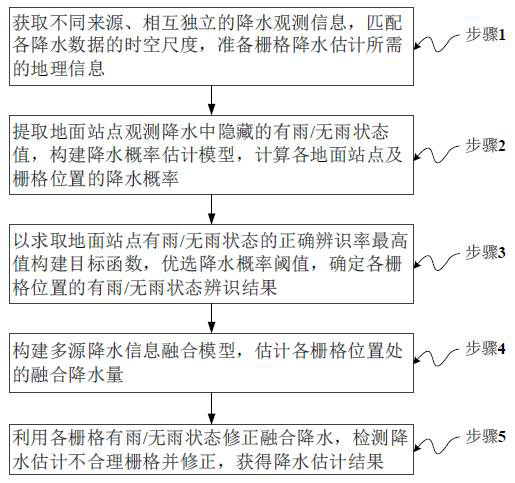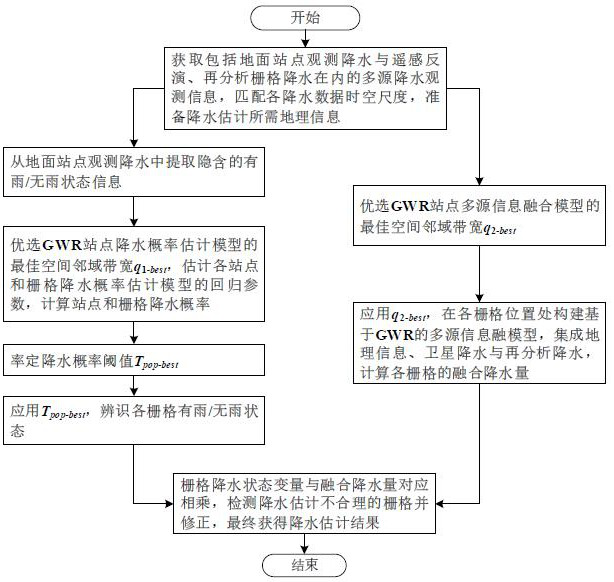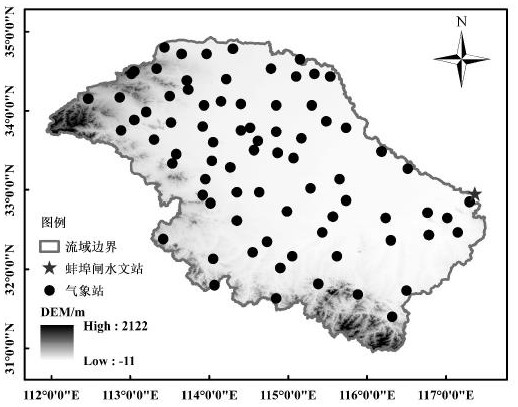Rainfall estimation method and system coupled with dry and wet state identification and multi-source information fusion
A multi-source information fusion and status technology, applied in resources, computing, computer-aided design, etc., can solve problems such as mutual interference of different information, lack of identification, range of rainy and non-rainy areas and spatial location deviations in estimated results, etc., to achieve Strong scalability and the effect of reducing quantitative estimation errors
- Summary
- Abstract
- Description
- Claims
- Application Information
AI Technical Summary
Problems solved by technology
Method used
Image
Examples
Embodiment 1
[0061] A method for estimating precipitation coupled with wet and dry state identification and multi-source information fusion, comprising the following steps:
[0062] Obtain different sources and independent multi-source precipitation observation information; extract the rain / no rain status value of the ground station based on the precipitation observed at the ground station, and use the geographic weighted regression model GWR to estimate the precipitation probability of the ground station and each grid; optimize the precipitation probability Threshold to identify the rain / no-rain status of the ground station and each grid; use the GWR method to fuse geographic and multi-source precipitation information to obtain grid fusion precipitation; use the grid rain / no-rain status identification results to correct the fusion precipitation , to get the precipitation estimation result.
Embodiment 2
[0064] On the basis of Embodiment 1, Embodiment 2 further proposes the refinement steps of the precipitation estimation method coupled with wet and dry state identification and multi-source information fusion, as follows:
[0065] Step 1. Data preprocessing: Obtain grid precipitation data from different sources and independent ground stations (weather stations, rainfall stations, etc.) in the study area to observe precipitation, remote sensing inversion, reanalysis, etc.; match the time of various grid precipitation data and spatial resolution; match the spatial scale of grid and site precipitation; prepare geographic information such as latitude and longitude, elevation, and slope of site and grid;
[0066] Step 11: Obtain multi-source precipitation observation information that is independent of each other from different sources;
[0067] Step 12: Determine the temporal and spatial resolution of the grid precipitation estimation; in terms of time, accumulate or decompose the ...
Embodiment 3
[0096] In this example, the catchment area above the Bengbu Gate hydrological station in the Huaihe River Basin is taken as the research area, and a precipitation estimation method coupled with wet and dry state identification and multi-source information fusion is proposed. The Huaihe River Basin is between the Yangtze River and the Yellow River, with an area of about 270,000 km 2 . The Bengbu Gate Hydrological Station is the main control station in the middle reaches of the Huaihe River. The longitude and latitude range of the catchment area controlled is 111.9°~117.5°E, 30.9°~34.9°N, with an area of about 117,000 km 2 . Butongbai Mountain and Funiu Mountain are in the northwest of the basin, Dabie Mountain is in the southwest, and the rest is a vast plain. The hilly area only accounts for 15.4% of the basin. The annual average precipitation is about 920 mm, which generally decreases from south to north, and the precipitation in the flood season (June-September) accoun...
PUM
 Login to View More
Login to View More Abstract
Description
Claims
Application Information
 Login to View More
Login to View More - R&D
- Intellectual Property
- Life Sciences
- Materials
- Tech Scout
- Unparalleled Data Quality
- Higher Quality Content
- 60% Fewer Hallucinations
Browse by: Latest US Patents, China's latest patents, Technical Efficacy Thesaurus, Application Domain, Technology Topic, Popular Technical Reports.
© 2025 PatSnap. All rights reserved.Legal|Privacy policy|Modern Slavery Act Transparency Statement|Sitemap|About US| Contact US: help@patsnap.com



